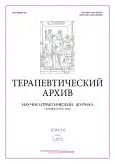Dyspnea: neurobiological and clinical aspects
- Authors: Chuchalin A.G.1
-
Affiliations:
- Pirogov Russian National Research Medical University
- Issue: Vol 94, No 3 (2022)
- Pages: 367-371
- Section: Editorial article
- URL: https://journals.rcsi.science/0040-3660/article/view/106359
- DOI: https://doi.org/10.26442/00403660.2022.03.201397
- ID: 106359
Cite item
Full Text
Abstract
An analysis of the results of studies carried out by specialists of the Russian Respiratory Society over the past 15 years is given. The article also includes the main provisions set out in the III Guidelines for dyspnea. A significant part of the manual is devoted to the recent achievements in studying neurophysiological processes in the brain structures during the development of dyspnea. These achievements were driven by image-diagnosis methods. An important aspect of this series of works for the clinical practice was identifying dyspnea domains and developing the instruments to assess severity. Analysis of the data on dyspnea from the clinical practice showed a highly heterogenic clinical picture, which must be taken into account in the management of individual patients. A diagnostic algorithm for long-term follow-up of patients with dyspnea syndrome is also discussed. The attention of doctors is drawn to the features of dyspnea during COVID-19; the disproportion between the sensory perception of respiratory discomfort and the degree of oxygen desaturation is emphasized. It was concluded that in the Russian-speaking environment of patients, doctors should actively use a verbal characteristic of dyspnea – the “language of dyspnea”.
Full Text
##article.viewOnOriginalSite##About the authors
Alexander G. Chuchalin
Pirogov Russian National Research Medical University
Author for correspondence.
Email: pulmomoskva@mail.ru
ORCID iD: 0000-0002-5070-5450
акад. РАН, д-р мед. наук, проф., зав. каф. госпитальной терапии педиатрического фак-та, председатель правления Российского респираторного общества
Russian Federation, MoscowReferences
- Dyspnea: Mechanisms, Measurement and Management. Eds DA Mahler, DE O'Donnell. 3rd ed. London, New York: CRC Press/Tailor & Francis, 2014.
- Simon PM, Schwartzstein RM, Weis JW, et al. Distinguishable types of dyspnea in patients with shortness of breath. Am Rev Respir Dis. 1990;142(5):1009-14. doi: 10.1164/ajrccm/142.5.1009
- Чучалин А.Г. Одышка: патофизиологические и клинические аспекты. Терапевтический архив. 2005;77(3):5-14 [Chuchalin AG. Dyspnoea: pathophysiologic and clinical aspects]. Terapevticheskii Arkhiv (Ter. Arkh.). 2005;77(3):5-14 (in Russian)].
- Трушенко Н.В., Чикина С.Ю., Лукашенко Е.П., Чучалин А.Г. Вербальные характеристики одышки у пациентов с хронической обструктивной болезнью легких и бронхиальной астмой. Пульмонология. 2011;3:70-80 [Trushenko NV, Chikina SYu, Lukashenko EP, Chuchalin AG. Verbal descriptions of dyspnea in patients with chronic obstructive pulmonary disease and bronchial asthma]. Pulmonologiya. 2011;3:70-80 (in Russian)]. doi: 10.18093/0869-0189-2011-0-3-70-80
- Абросимов В.Н. Гиповентиляционный синдром: методические рекомендации. Рязань, 1989 [Abrosimov VN. Gipoventiliatsionnyi sindrom: metodicheskie rekomendatsii. Ryazan, 1989 (in Russian)].
- Абросимов В.Н. Гиповентиляция и гипервентиляционный синдром. В кн.: Респираторная медицина: руководство. Под ред. А.Г. Чучалина. М.: ГЭОТАР-Медиа, 2007. Т. 2; с. 511-3 [Abrosimov VN. Gipoventiliatsiia i giperventiliatsionnyi sindrom. V kn.: Respiratornaia meditsina: rukovodstvo. Pod red. AG Chuchalina. Moscow: GEOTAR-Media, 2007. Vol. 2; p. 511-3 (in Russian)].
- Nishimura K, Izumi T, Tsukino M, Oga T. Dyspnea is better predictor of 5-year survival than airway obstruction in patients with COPD. Chest. 2002;121(5):1434-40. doi: 10.1378/chest.121.5.1434
- Abidov A, Rozanski A, Hachamovitch R, et al. Prognostic significance of dyspnea in patients referred for cardiac stress testing. N Engl J Med. 2005;353(18):1889-98. doi: 10.1056/NEJMoa042741
- Evans KС, Benzett RВ. Neuroimaging of dyspnea. In: Dyspnea: Mechanisms, Measurement and Management. Eds DA Mahler, DE O'Donnell. 3rd ed. London, New York: CRC Press/Tailor & Francis, 2014; p. 11-24.
- Guenette JА, Jensen D. Aging and sex differences. In: Dyspnea: Mechanisms, Measurement and Management. Eds DA Mahler, DE O'Donnell. 3rd ed. London, New York: CRC Press/Tailor & Francis, 2014; p. 25-38.
- Jensen D, O'Donnell DE. Pregnancy/obesity. In: Dyspnea: Mechanisms, Measurement and Management. Eds DA Mahler, DE O'Donnell. 3rd ed. London, New York: CRC Press/Tailor & Francis, 2014; p. 39-54.
- Jones NL. The ins and outs of breathing: how we learnt about the body’s most vital function. Bloomingtone: iUniverse, 2011.
Supplementary files







